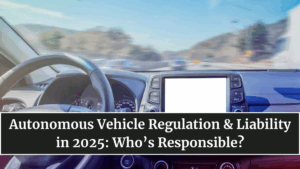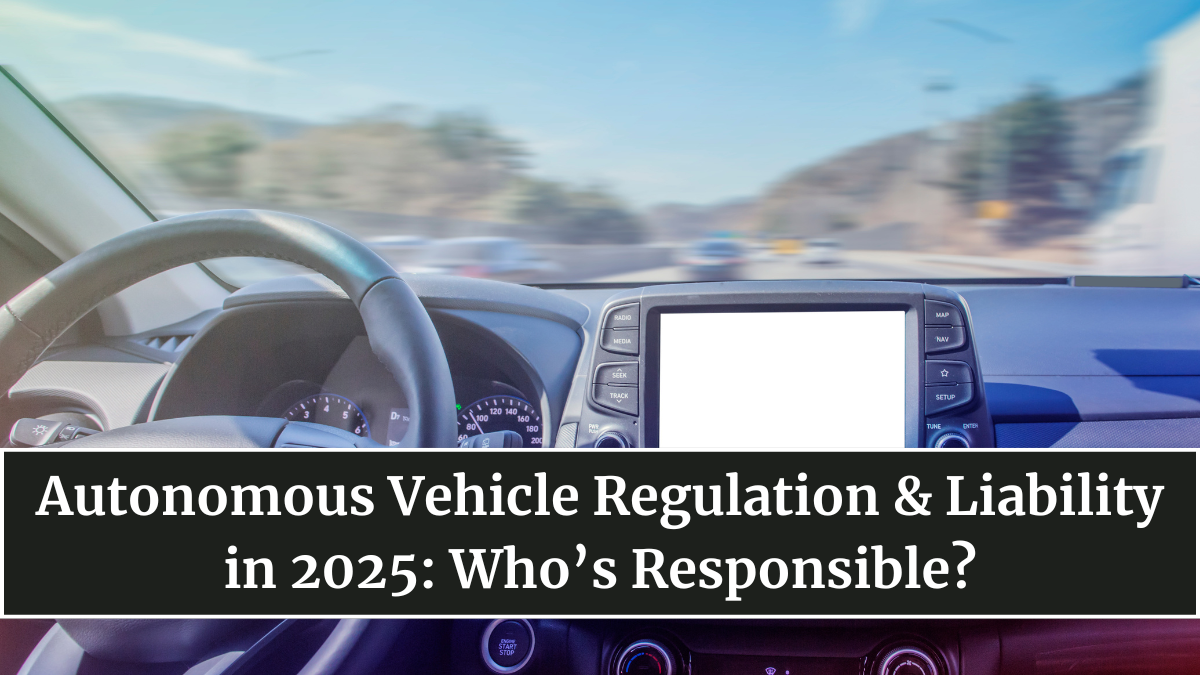The self-driving revolution is no longer futuristic — it’s here, and it’s forcing lawmakers worldwide to confront one crucial question: Who’s responsible when an autonomous vehicle makes a mistake?
By 2025, the global automotive industry is standing at a legal crossroads. As cars shift from human-driven to AI-operated machines, the traditional concepts of driver responsibility, insurance, and traffic law are being rewritten. Regulators, automakers, and tech companies are racing to define how liability works in a driverless ecosystem — because when no one is at the wheel, accountability gets complicated.

The Global Push for Regulation
Governments are adapting rapidly to the arrival of autonomous vehicles (AVs). Countries like the United States, Germany, Japan, and the UK have already established frameworks for driverless testing and operation.
Key 2025 Developments:
-
United States: The National Highway Traffic Safety Administration (NHTSA) has introduced clearer safety standards for Level 3–5 autonomous systems, requiring manufacturers to log decision-making data for every critical incident.
-
European Union: The EU’s new “AI Act” includes specific clauses for automated vehicle liability and mandates transparency in AI decision systems.
-
India: The Ministry of Road Transport & Highways has initiated pilot rules for semi-autonomous operation in controlled environments, focusing on commercial and public transport use.
-
China: Pushing ahead with large-scale deployment, China’s regulatory model ties AI vehicle performance directly to national data networks for real-time supervision.
These regulatory structures share a common goal — to create accountability without stifling innovation.
Understanding Levels of Autonomy and Legal Responsibility
Before defining liability, it’s essential to distinguish between different autonomy levels (SAE 0–5):
| Level | Control | Driver Responsibility | Example |
|---|---|---|---|
| 0 | Full manual | Complete | Regular cars |
| 1–2 | Partial automation | Shared | Adaptive cruise control |
| 3 | Conditional automation | Driver must intervene when prompted | Tesla Autopilot, Honda Sensing |
| 4 | High automation | No human required in most conditions | Waymo, Cruise AV |
| 5 | Full automation | No human intervention at all | Future autonomous taxis |
As autonomy increases, human accountability decreases, transferring responsibility to the software, manufacturer, or even the algorithm itself.
Who Is Liable in an AV Accident?
This question forms the core of every new regulation. Traditionally, the driver bore legal responsibility for accidents. In autonomous driving, that shifts depending on context:
-
Level 2–3: Shared liability — both driver and manufacturer may share blame.
-
Level 4–5: Manufacturer or software developer bears primary responsibility.
-
Edge cases: Infrastructure failure, data manipulation, or sensor errors may shift accountability to third parties.
Legal experts are advocating for a “shared fault matrix”, assigning percentages of liability to each entity — manufacturer, operator, AI system, and road authority — depending on evidence and system data logs.
Insurance Models for the Autonomous Era
Insurance providers are redesigning policies to adapt to AI-driven vehicles. Traditional driver-based premiums are being replaced by usage-based or system-fault-based insurance.
Emerging trends in 2025 include:
-
Manufacturer-backed coverage: Automakers like Tesla and Volvo offer insurance directly, covering autonomous faults.
-
Data-driven risk assessment: Insurers analyze sensor and driving logs instead of human records.
-
On-demand liability models: Fleets like Uber and Cruise use dynamic coverage activated only during autonomous operation.
In essence, the insurance industry is moving from insuring drivers to insuring algorithms.
Legal Challenges in Assigning Fault
Determining who’s responsible after an autonomous crash is far from simple. Challenges include:
-
Data Transparency: Manufacturers may restrict access to driving logs or algorithmic decision data, complicating investigations.
-
AI Decision Complexity: Unlike human negligence, AI behavior is statistical — determining “intent” or “error” becomes subjective.
-
Cross-Border Differences: Laws differ by country, making global operations legally fragmented.
-
Software Updates: Post-sale updates can alter driving behavior, raising questions about responsibility at the time of an incident.
-
Cybersecurity Risks: Hacks or tampering could cause accidents beyond any single entity’s control.
To address this, regulators are mandating black box systems in autonomous vehicles, similar to aviation flight recorders, to store critical decision data.
India’s Approach to AV Regulation
India’s journey toward autonomous driving is more cautious but pragmatic. While full automation is years away, semi-autonomous features like ADAS, lane assist, and auto braking are now standard in premium cars.
The government’s draft framework emphasizes:
-
Driver override priority: Even in automated mode, human drivers retain ultimate control.
-
Mandatory AI logs: Every autonomous function must store decision data for accountability.
-
Testing permissions: Only approved zones (like highways or industrial parks) can host fully autonomous trials.
These steps are designed to build trust before nationwide deployment, balancing safety with innovation.
The Ethical and Legal Gray Zone
Beyond regulation lies the moral dilemma — can an AI be held legally responsible? Courts are grappling with whether to treat AI systems as extensions of manufacturers or independent decision-makers.
Philosophical questions emerge:
-
If an autonomous car avoids five pedestrians by hitting one, is it guilty of manslaughter or fulfilling a safety algorithm?
-
Should AI decision-making follow human moral codes, or prioritize mathematical efficiency?
Legal scholars are debating the need for AI-specific legal entities, where responsibility is partially borne by the software itself, supported by regulatory oversight.
What’s Next for AV Regulation by 2030
The coming years will define how society adapts to autonomous mobility. Key trends shaping this legal evolution include:
-
Unified global standards for AI vehicle certification and liability.
-
Mandatory AI ethics guidelines integrated into coding frameworks.
-
Blockchain-based evidence logs to prevent tampering during investigations.
-
Public-private insurance models for shared responsibility.
-
AI licensing systems similar to human driver licenses.
The goal is not just to regulate technology but to create a trustworthy ecosystem where automation enhances safety, not uncertainty.
FAQs
Who is responsible if a self-driving car crashes?
Liability depends on the automation level. In Level 4–5 vehicles, the manufacturer or software provider is usually held accountable.
How are regulators handling autonomous car accidents?
Authorities now require data logs from vehicles to determine system behavior, similar to aircraft black boxes.
Do insurance models cover AI-driven accidents?
Yes. Modern insurance policies are shifting toward fault-based systems focused on software and data rather than driver history.
Is India ready for autonomous cars?
India is testing semi-autonomous systems in limited environments, with a focus on safety, data logging, and regulatory compliance.
What’s the biggest legal challenge for AVs?
Assigning blame — especially when AI decisions are made autonomously and without human intent.
Click here to know more.
